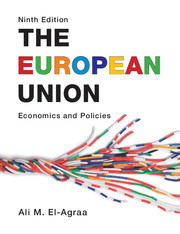Book contents
- Frontmatter
- Contents
- Figures
- Tables
- Boxes
- Contributors
- Preface
- A reader’s guide
- Abbreviations
- 1 General introduction
- Part I EU history, institutions and legal dimension
- Part II EU market integration
- Part III EU monetary integration
- 10 The theory of monetary integration
- 11 The development of EU economic and monetary integration
- 12 The Operation of EMU
- Part IV The single European market
- Part V EU budget and structural policies
- Part VI EU external relations
- Part VII The future of the EU
- Bibliography
- Author Index
- Index
- References
11 - The development of EU economic and monetary integration
from Part III - EU monetary integration
- Frontmatter
- Contents
- Figures
- Tables
- Boxes
- Contributors
- Preface
- A reader’s guide
- Abbreviations
- 1 General introduction
- Part I EU history, institutions and legal dimension
- Part II EU market integration
- Part III EU monetary integration
- 10 The theory of monetary integration
- 11 The development of EU economic and monetary integration
- 12 The Operation of EMU
- Part IV The single European market
- Part V EU budget and structural policies
- Part VI EU external relations
- Part VII The future of the EU
- Bibliography
- Author Index
- Index
- References
Summary
Introduction
The aim of achieving economic and monetary union (EMU), although enshrined in the Treaty on European Union (TEU, or the Maastricht Treaty), and hence in the Treaty of Lisbon, is not a new phenomenon for the EU (see Chapter 2). This chapter provides a historical perspective by travelling the route taken by the EU in this direction. The actual route followed has been the combination of the objectives for increasing economic integration, paving the way for what some hoped to be the political unity of Europe (see Section 2.2.2, page 25), and the more immediate economic needs and shocks along that path. Nevertheless, the initial ideas, sketched out as early as 1970, bear striking similarities to what has eventually been accomplished.
The chapter begins by considering the first attempt at EMU, based on the 1971 Werner Report, which committed then European Community (EC) member states (MSs) to achieving it in three stages, beginning in 1971 and finishing in 1980. After examining the reasons for its failure, it goes on to tackle the 1979 European Monetary System (EMS), a limited arrangement aimed at dealing with the monetary upheavals of the time by creating a zone of monetary stability. It then turns to the revival of EMU in the two Delors reports, which culminated in its formal adoption in the 1992 Maastricht Treaty, again to be achieved in three stages, beginning in 1990 and finishing in 1997, or 1999 at the very latest. We then look into how it has progressed and why some MSs remain outside, before offering our conclusions.
- Type
- Chapter
- Information
- The European UnionEconomics and Policies, pp. 163 - 181Publisher: Cambridge University PressPrint publication year: 2011



